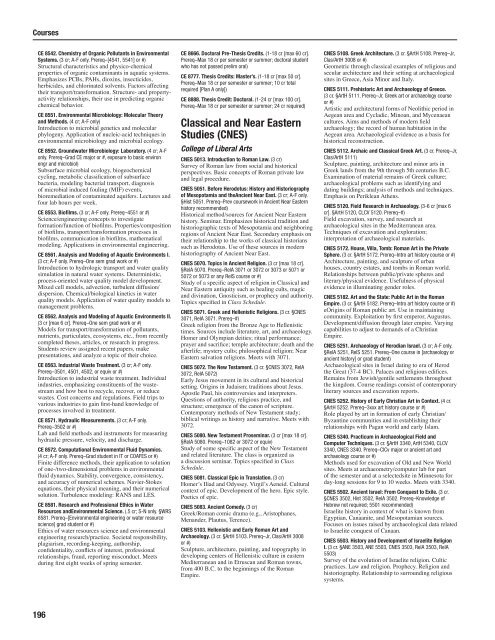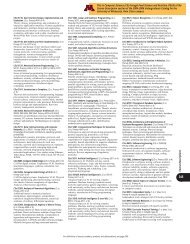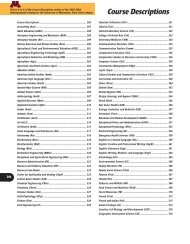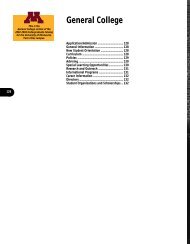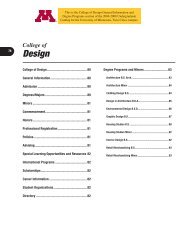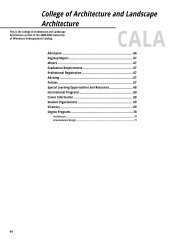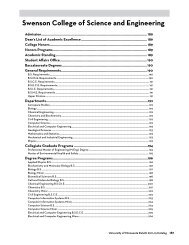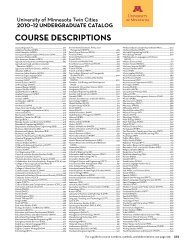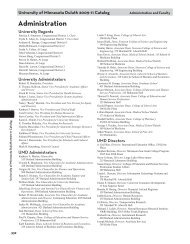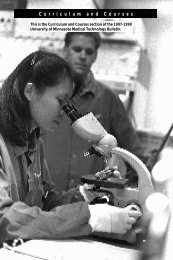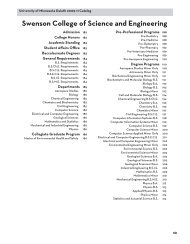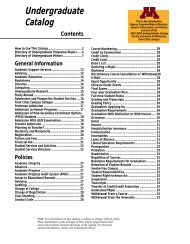Accounting through Education and Human Development - University ...
Accounting through Education and Human Development - University ...
Accounting through Education and Human Development - University ...
Create successful ePaper yourself
Turn your PDF publications into a flip-book with our unique Google optimized e-Paper software.
Courses<br />
CE 8542. Chemistry of Organic Pollutants in Environmental<br />
Systems. (3 cr; A-F only. Prereq–[4541, 5541] or #)<br />
Structural characteristics <strong>and</strong> physico-chemical<br />
properties of organic contaminants in aquatic systems.<br />
Emphasizes PCBs, PAHs, dioxins, insecticides,<br />
herbicides, <strong>and</strong> chlorinated solvents. Factors affecting<br />
their transport/transformation. Structure- <strong>and</strong> propertyactivity<br />
relationships, their use in predicting organic<br />
chemical behavior.<br />
CE 8551. Environmental Microbiology: Molecular Theory<br />
<strong>and</strong> Methods. (4 cr; A-F only)<br />
Introduction to microbial genetics <strong>and</strong> molecular<br />
phylogeny. Application of nucleic-acid techniques in<br />
environmental microbiology <strong>and</strong> microbial ecology.<br />
CE 8552. Groundwater Microbiology: Laboratory. (4 cr; A-F<br />
only. Prereq–Grad CE major or #, exposure to basic environ<br />
engr <strong>and</strong> microbiol)<br />
Subsurface microbial ecology, biogeochemical<br />
cycling, metabolic classification of subsurface<br />
bacteria, modeling bacterial transport, diagnosis<br />
of microbial induced fouling (MIF) events,<br />
bioremediation of contaminated aquifers. Lectures <strong>and</strong><br />
four lab hours per week.<br />
CE 8553. Biofilms. (3 cr; A-F only. Prereq–4551 or #)<br />
Science/engineering concepts to investigate<br />
formation/function of biofilms. Properties/composition<br />
of biofilms, transport/transformation processes in<br />
biofilms, communication in biofilms, mathematical<br />
modeling. Applications in environmental engineering.<br />
CE 8561. Analysis <strong>and</strong> Modeling of Aquatic Environments I.<br />
(3 cr; A-F only. Prereq–One sem grad work or #)<br />
Introduction to hydrologic transport <strong>and</strong> water quality<br />
simulation in natural water systems. Deterministic,<br />
process-oriented water quality model development.<br />
Mixed cell models, advection, turbulent diffusion/<br />
dispersion. Chemical/biological kinetics in water<br />
quality models. Application of water quality models to<br />
management problems.<br />
CE 8562. Analysis <strong>and</strong> Modeling of Aquatic Environments II.<br />
(3 cr [max 6 cr]. Prereq–One sem grad work or #)<br />
Models for transport/transformation of pollutants,<br />
nutrients, particulates, ecosystems, etc., from recently<br />
completed theses, articles, or research in progress.<br />
Students review assigned recent papers, make<br />
presentations, <strong>and</strong> analyze a topic of their choice.<br />
CE 8563. Industrial Waste Treatment. (3 cr; A-F only.<br />
Prereq–3501, 4501, 4502, or equiv or #)<br />
Introduction to industrial waste treatment. Individual<br />
industries, emphasizing constituents of the wastestream<br />
<strong>and</strong> how best to recycle, recover, or reduce<br />
wastes. Cost concerns <strong>and</strong> regulations. Field trips to<br />
various industries to gain first-h<strong>and</strong> knowledge of<br />
processes involved in treatment.<br />
CE 8571. Hydraulic Measurements. (3 cr; A-F only.<br />
Prereq–3502 or #)<br />
Lab <strong>and</strong> field methods <strong>and</strong> instruments for measuring<br />
hydraulic pressure, velocity, <strong>and</strong> discharge.<br />
CE 8572. Computational Environmental Fluid Dynamics.<br />
(4 cr; A-F only. Prereq–Grad student in IT or COAFES or #)<br />
Finite difference methods, their application to solution<br />
of one-/two-dimensional problems in environmental<br />
fluid dynamics. Stability, convergence, consistency,<br />
<strong>and</strong> accuracy of numerical schemes. Navier-Stokes<br />
equations, their physical meaning, <strong>and</strong> their numerical<br />
solution. Turbulence modeling: RANS <strong>and</strong> LES.<br />
CE 8581. Research <strong>and</strong> Professional Ethics in Water<br />
Resources <strong>and</strong>Environmental Science. (.5 cr; S-N only. §WRS<br />
8581. Prereq–[Environmental engineering or water resource<br />
science] grad student or #)<br />
Ethics of water resources science <strong>and</strong> environmental<br />
engineering research/practice. Societal responsibility,<br />
plagiarism, recording-keeping, authorship,<br />
confidentiality, conflicts of interest, professional<br />
relationships, fraud, reporting misconduct. Meets<br />
during first eight weeks of spring semester.<br />
CE 8666. Doctoral Pre-Thesis Credits. (1-18 cr [max 60 cr].<br />
Prereq–Max 18 cr per semester or summer; doctoral student<br />
who has not passed prelim oral)<br />
CE 8777. Thesis Credits: Master’s. (1-18 cr [max 50 cr].<br />
Prereq–Max 18 cr per semester or summer; 10 cr total<br />
required [Plan A only])<br />
CE 8888. Thesis Credit: Doctoral. (1-24 cr [max 100 cr].<br />
Prereq–Max 18 cr per semester or summer; 24 cr required)<br />
Classical <strong>and</strong> Near Eastern<br />
Studies (CNES)<br />
College of Liberal Arts<br />
CNES 5013. Introduction to Roman Law. (3 cr)<br />
Survey of Roman law from social <strong>and</strong> historical<br />
perspectives. Basic concepts of Roman private law<br />
<strong>and</strong> legal procedure.<br />
CNES 5051. Before Herodotus: History <strong>and</strong> Historiography<br />
of Mesopotamia <strong>and</strong> theAncient Near East. (3 cr; A-F only.<br />
§Hist 5051. Prereq–Prev coursework in Ancient Near Eastern<br />
history recommended)<br />
Historical method/sources for Ancient Near Eastern<br />
history. Seminar. Emphasizes historical tradition <strong>and</strong><br />
historiographic texts of Mesopotamia <strong>and</strong> neighboring<br />
regions of Ancient Near East. Secondary emphasis on<br />
their relationship to the works of classical historians<br />
such as Herodotus. Use of these sources in modern<br />
historiography of Ancient Near East.<br />
CNES 5070. Topics in Ancient Religion. (3 cr [max 18 cr].<br />
§RelA 5070. Prereq–RelA 3071 or 3072 or 3073 or 5071 or<br />
5072 or 5073 or any RelS course or #)<br />
Study of a specific aspect of religion in Classical <strong>and</strong><br />
Near Eastern antiquity such as healing cults, magic<br />
<strong>and</strong> divination, Gnosticism, or prophecy <strong>and</strong> authority.<br />
Topics specified in Class Schedule.<br />
CNES 5071. Greek <strong>and</strong> Hellenistic Religions. (3 cr. §CNES<br />
3071, RelA 3071. Prereq–#)<br />
Greek religion from the Bronze Age to Hellenistic<br />
times. Sources include literature, art, <strong>and</strong> archaeology.<br />
Homer <strong>and</strong> Olympian deities; ritual performance;<br />
prayer <strong>and</strong> sacrifice; temple architecture; death <strong>and</strong> the<br />
afterlife; mystery cults; philosophical religion; Near<br />
Eastern salvation religions. Meets with 3071.<br />
CNES 5072. The New Testament. (3 cr. §CNES 3072, RelA<br />
3072, RelA 5072)<br />
Early Jesus movement in its cultural <strong>and</strong> historical<br />
setting. Origins in Judaism; traditions about Jesus.<br />
Apostle Paul, his controversies <strong>and</strong> interpreters.<br />
Questions of authority, religious practice, <strong>and</strong><br />
structure; emergence of the canon of scripture.<br />
Contemporary methods of New Testament study;<br />
biblical writings as history <strong>and</strong> narrative. Meets with<br />
3072.<br />
CNES 5080. New Testament Proseminar. (3 cr [max 18 cr].<br />
§RelA 5080. Prereq–1082 or 3072 or equiv)<br />
Study of some specific aspect of the New Testament<br />
<strong>and</strong> related literature. The class is organized as<br />
a discussion seminar. Topics specified in Class<br />
Schedule.<br />
CNES 5081. Classical Epic in Translation. (3 cr)<br />
Homerʼs Iliad <strong>and</strong> Odyssey. Virgilʼs Aeneid. Cultural<br />
context of epic. <strong>Development</strong> of the hero. Epic style.<br />
Poetics of epic.<br />
CNES 5083. Ancient Comedy. (3 cr)<br />
Greek/Roman comic drama (e.g., Aristophanes,<br />
Men<strong>and</strong>er, Plautus, Terence).<br />
CNES 5103. Hellenistic <strong>and</strong> Early Roman Art <strong>and</strong><br />
Archaeology. (3 cr. §ArtH 5103. Prereq–Jr, Clas/ArtH 3008<br />
or #)<br />
Sculpture, architecture, painting, <strong>and</strong> topography in<br />
developing centers of Hellenistic culture in eastern<br />
Mediterranean <strong>and</strong> in Etruscan <strong>and</strong> Roman towns,<br />
from 400 B.C. to the beginnings of the Roman<br />
Empire.<br />
CNES 5108. Greek Architecture. (3 cr. §ArtH 5108. Prereq–Jr,<br />
Clas/ArtH 3008 or #)<br />
Geometric <strong>through</strong> classical examples of religious <strong>and</strong><br />
secular architecture <strong>and</strong> their setting at archaeological<br />
sites in Greece, Asia Minor <strong>and</strong> Italy.<br />
CNES 5111. Prehistoric Art <strong>and</strong> Archaeology of Greece.<br />
(3 cr. §ArtH 5111. Prereq–Jr, Greek art or archaeology course<br />
or #)<br />
Artistic <strong>and</strong> architectural forms of Neolithic period in<br />
Aegean area <strong>and</strong> Cycladic, Minoan, <strong>and</strong> Mycenaean<br />
cultures. Aims <strong>and</strong> methods of modern field<br />
archaeology; the record of human habitation in the<br />
Aegean area. Archaeological evidence as a basis for<br />
historical reconstruction.<br />
CNES 5112. Archaic <strong>and</strong> Classical Greek Art. (3 cr. Prereq–Jr,<br />
Clas/ArtH 5111)<br />
Sculpture, painting, architecture <strong>and</strong> minor arts in<br />
Greek l<strong>and</strong>s from the 9th <strong>through</strong> 5th centuries B.C.<br />
Examination of material remains of Greek culture;<br />
archaeological problems such as identifying <strong>and</strong><br />
dating buildings; analysis of methods <strong>and</strong> techniques.<br />
Emphasis on Periklean Athens.<br />
CNES 5120. Field Research in Archaeology. (3-6 cr [max 6<br />
cr]. §ArtH 5120, CLCV 5120. Prereq–#)<br />
Field excavation, survey, <strong>and</strong> research at<br />
archaeological sites in the Mediterranean area.<br />
Techniques of excavation <strong>and</strong> exploration;<br />
interpretation of archaeological materials.<br />
CNES 5172. House, Villa, Tomb: Roman Art in the Private<br />
Sphere. (3 cr. §ArtH 5172. Prereq–Intro art history course or #)<br />
Architecture, painting, <strong>and</strong> sculpture of urban<br />
houses, country estates, <strong>and</strong> tombs in Roman world.<br />
Relationships between public/private spheres <strong>and</strong><br />
literary/physical evidence. Usefulness of physical<br />
evidence in illuminating gender roles.<br />
CNES 5182. Art <strong>and</strong> the State: Public Art in the Roman<br />
Empire. (3 cr. §ArtH 5182. Prereq–Intro art history course or #)<br />
eOrigins of Roman public art. Use in maintaining<br />
community. Exploitation by first emperor, Augustus.<br />
<strong>Development</strong>/diffusion <strong>through</strong> later empire. Varying<br />
capabilities to adjust to dem<strong>and</strong>s of a Christian<br />
Empire.<br />
CNES 5251. Archaeology of Herodian Israel. (3 cr; A-F only.<br />
§RelA 5251, RelS 5251. Prereq–One course in [archaeology or<br />
ancient history] or grad student)<br />
Archaeological sites in Israel dating to era of Herod<br />
the Great (37-4 BC). Palaces <strong>and</strong> religious edifices.<br />
Remains from Jewish/gentile settlements <strong>through</strong>out<br />
the kingdom. Course readings consist of contemporary<br />
literary sources <strong>and</strong> excavation reports.<br />
CNES 5252. History of Early Christian Art in Context. (4 cr.<br />
§ArtH 5252. Prereq–3xxx art history course or #)<br />
Role played by art in formation of early Christian/<br />
Byzantine communities <strong>and</strong> in establishing their<br />
relationships with Pagan world <strong>and</strong> early Islam.<br />
CNES 5340. Practicum in Archaeological Field <strong>and</strong><br />
Computer Techniques. (3 cr. §ArtH 3340, ArtH 5340, CLCV<br />
3340, CNES 3340. Prereq–ClCv major or ancient art <strong>and</strong><br />
archaeology course or #)<br />
Methods used for excavation of Old <strong>and</strong> New World<br />
sites. Meets at archaeometry/computer lab for part<br />
of the semester <strong>and</strong> at a selectedsite in Minnesota for<br />
day-long sessions for 9 to 10 weeks. Meets with 3340.<br />
CNES 5502. Ancient Israel: From Conquest to Exile. (3 cr.<br />
§CNES 3502, Hist 3502, RelA 3502. Prereq–Knowledge of<br />
Hebrew not required; 5501 recommended)<br />
Israelite history in context of what is known from<br />
Egyptian, Canaanite, <strong>and</strong> Mesopotamian sources.<br />
Focuses on issues raised by archaeological data related<br />
to Israelite conquest of Canaan.<br />
CNES 5503. History <strong>and</strong> <strong>Development</strong> of Israelite Religion<br />
I. (3 cr. §ANE 3503, ANE 5503, CNES 3503, RelA 3503, RelA<br />
5503)<br />
Survey of the evolution of Israelite religion. Cultic<br />
practices. Law <strong>and</strong> religion. Prophecy. Religion <strong>and</strong><br />
historiography. Relationship to surrounding religious<br />
systems.<br />
196


